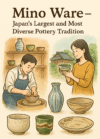
Nestled in the Tōnō region of Gifu Prefecture, Mino Ware (Mino-yaki) has been crafted for over 1,300 years. As Japan’s largest pottery-producing area, it accounts for the majority of ceramics used in everyday life across the country. But Mino Ware is not defined by a single style — instead, it is celebrated for its remarkable variety.
During the Momoyama period (late 16th century), Mino potters created distinctive styles such as Shino, with its soft white glaze and subtle pinhole texture, and Oribe, known for its vivid green copper glaze and bold, asymmetrical designs. These styles, deeply tied to the Japanese tea ceremony, became symbols of refined taste and artistic innovation.
Today, Mino Ware continues to evolve. While traditional tea bowls, plates, and sake cups are still treasured, modern artisans experiment with new shapes, glazes, and designs to suit contemporary lifestyles. Visitors to the Tōnō area can explore pottery workshops, try hands-on ceramic painting, and shop for everything from rustic, handmade tea cups to sleek, minimalist dinnerware.
For those who love Japanese culture, Mino Ware offers a bridge between history and modern living — a chance to bring a piece of Japan’s ceramic heritage into your home.
美濃焼 ― 日本最大で最も多様な陶器の伝統
岐阜県東濃地方に位置する美濃焼は、1300年以上にわたり作られてきました。日本最大の陶器生産地として、美濃焼は全国の日常生活で使われる陶磁器の大部分を占めています。しかし、美濃焼は一つの様式によって定義されるものではなく、その驚くべき多様性によって称賛されています。
桃山時代(16世紀後半)には、美濃の陶工たちは、柔らかな白い釉薬と小さなピンホール状の質感を持つ志野や、鮮やかな緑色の銅釉と大胆で非対称なデザインで知られる織部といった独特の様式を生み出しました。これらの様式は日本の茶道と深く結びつき、洗練された趣味と芸術的革新の象徴となりました。
今日でも美濃焼は進化を続けています。伝統的な茶碗や皿、酒器が今なお大切にされる一方で、現代の職人たちは、現代のライフスタイルに合わせて新しい形や釉薬、デザインに挑戦しています。東濃地方を訪れる人々は、陶芸工房を巡り、陶器の絵付けを体験し、素朴な手作りの湯のみから洗練されたミニマルな食器まで、あらゆる品を購入することができます。
日本文化を愛する人にとって、美濃焼は歴史と現代生活をつなぐ架け橋であり、日本の陶磁器の遺産を自宅に迎え入れる機会なのです。
